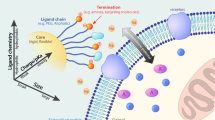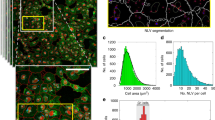Abstract
Understanding how nanoparticles with different shapes interact with cell membranes is important in drug and gene delivery1,2,3,4, but this interaction remains poorly studied3. Using computer simulations, we investigate the physical translocation processes of nanoparticles with different shapes (for example, spheres, ellipsoids, rods, discs and pushpin-like particles) and volumes across a lipid bilayer. We find that the shape anisotropy and initial orientation of the particle are crucial to the nature of the interaction between the particle and lipid bilayer. The penetrating capability of a nanoparticle across a lipid bilayer is determined by the contact area between the particle and lipid bilayer, and the local curvature of the particle at the contact point. Particle volume affects translocation indirectly, and particle rotation can complicate the penetration process. Our results provide a practical guide to geometry considerations when designing nanoscale cargo carriers.
This is a preview of subscription content, access via your institution
Access options
Subscribe to this journal
Receive 12 print issues and online access
$259.00 per year
only $21.58 per issue
Buy this article
- Purchase on Springer Link
- Instant access to full article PDF
Prices may be subject to local taxes which are calculated during checkout





Similar content being viewed by others
References
Service, R. F. Nanotechnology takes aim at cancer. Science 310, 1132–1134 (2005).
Xia, Y. Nanomaterials at work in biomedical research. Nature Mater. 7, 758–760 (2008).
Mitragotri, S. & Lahann, J. Physical approaches to biomaterial design. Nature Mater. 8, 15–23 (2008).
Nel, A. et al. Understanding biophysicochemical interactions at the nano–bio interface. Nature Mater. 8, 543–557 (2009).
Decuzzi, P. & Ferrari, M. The receptor-mediated endocytosis of nonspherical particles. Biophys. J. 94, 3790–3797 (2008).
Xia, T. et al. Comparison of the abilities of ambient and manufactured nanoparticles to induce cellular toxicity according to an oxidative stress paradigm. Nano Lett. 6, 1794–1807 (2006).
Poland, C. A. et al. Carbon nanotubes introduced into the abdominal cavity of mice show asbestos-like pathogenicity in a pilot study. Nature Nanotech. 3, 423–428 (2008).
Livadaru, L. & Kovalenko, A. Fundamental mechanism of translocation across liquidlike membranes: toward control over nanoparticle behavior. Nano Lett. 6, 78–83 (2006).
Roiter, Y. et al. Interaction of nanoparticles with lipid membrane. Nano Lett. 8, 941–944 (2008).
Obataya, I., Nakamura, C., Han, S., Nakamura, N. & Miyake, J. Nanoscale operation of a living cell using an atomic force microscope with a nanoneedle. Nano Lett. 5, 27–30 (2005).
Wong-Ekkabut, J. et al. Computer simulation study of fullerene translocation through lipid membranes. Nature Nanotech. 3, 363–368 (2008).
Qiao, R., Roberts, A. P., Mount, A. S., Klaine, S. J. & Ke, P. C. Translocation of C60 and its derivatives across a lipid bilayer. Nano Lett. 7, 614–619 (2007).
Wallace, E. J. & Sansom, M. S. P. Blocking of carbon nanotube based nanoinjectors by lipids: a simulation study. Nano Lett. 8, 2751–2756 (2008).
Chen, X., Kis, A., Zettl, A. & Bertozzi, C. R. A cell nanoinjector based on carbon nanotubes. Proc. Natl Acad. Sci. USA 104, 8218–8222 (2007).
Vakarelski, I. U., Brown, S. C., Higashitani, K. & Moudgil, B. M. Penetration of living cell membranes with fortified carbon nanotube tips. Langmuir 23, 10893–10896 (2007).
Leroueil, P. R. et al. Wide varieties of cationic nanoparticles induce defects in supported lipid bilayers. Nano Lett. 8, 420–424 (2008).
Hong, S. P. et al. Interaction of polycationic polymers with supported lipid bilayers and cells: nanoscale hole formation and enhanced membrane permeability. Bioconjugate Chem. 17, 728–734 (2006).
Leroueil, P. R. et al. Nanoparticle interaction with biological membranes: does nanotechnology present a janus face? Acc. Chem. Res. 40, 335–342 (2007).
Ginzburg, V. V. & Balijepailli, S. Modeling the thermodynamics of the interaction of nanoparticles with cell membranes. Nano Lett. 7, 3716–3722 (2007).
Zasloff, M. Magainins, a class of antimicrobial peptides from Xenopus skin: isolation, characterization of two active forms and partial cDNA sequence of a precursor. Proc. Natl Acad. Sci. USA 84, 5449–5453 (1987).
Cossart, P. Perspectives series: host/pathogen interactions. J. Clin. Invest. 99, 2307–2311 (1997).
Champion, J. A. & Mitragotri, S. Role of target geometry in phagocytosis. Proc. Natl Acad. Sci. USA 103, 4930–4934 (2006).
Gratton, S. E. A. et al. The effect of particle design on cellular internalization pathways. Proc. Natl Acad. Sci. USA 105, 11613–11618 (2008).
Glotzer, S. C. & Solomon, M. J. Anisotropy of building blocks and their assembly into complex structures. Nature Mater. 6, 557–562 (2008).
Shillcock, J. C. & Lipowsky, R. Tension-induced fusion of bilayer membranes and vesicles. Nature Mater. 4, 225–228 (2005).
Laradji, M. & Kumar, P. B. S. Dynamics of domain growth in self-assembled fluid vesicles. Phys. Rev. Lett. 93, 198105 (2004).
Schmidt, U., Guigas, G. & Weiss, M. Cluster formation of transmembrane proteins due to hydrophobic mismatching. Phys. Rev. Lett. 101, 128104 (2008).
Alexeev, A., Uspal, W. E. & Balazs, A. C. Harnessing janus nanoparticles to create controllable pores in membranes. ACS Nano 2, 1117–1122 (2008).
Jiang, W., Kim, B. Y. S., Rutka, J. T. & Chan, W. C. W. Nanoparticle-mediated cellular response is size-dependent. Nature Nanotech. 3, 145–150 (2008).
Song, L. Z. et al. Structure of staphylococcal-hemolysin, a heptameric transmembrane pore. Science 274, 1859–1865 (1996).
Acknowledgements
The authors thank R. Austin, M. Laradji, I. Szleifer, Z. Zhang, W. Tian, C. Ren and X. Shi for helpful discussions. This work was supported by the National Basic Research Program of China under grant no. 2007CB925101 and the National Natural Science Foundation of China under grant no. 10974080.
Author information
Authors and Affiliations
Contributions
K.Y. and Y.Q.M. conceived and designed the simulations. K.Y. and Y.Q.M. performed the simulations. K.Y. and Y.Q.M. analysed the data. K.Y. and Y.Q.M. co-wrote the paper. All authors discussed the results and commented on the manuscript.
Corresponding author
Ethics declarations
Competing interests
The authors declare no competing financial interests.
Supplementary information
Supplementary information
Supplementary information (PDF 1602 kb)
Supplementary information
Supplementary movie 1 (MOV 442 kb)
Supplementary information
Supplementary movie 2 (MOV 468 kb)
Supplementary information
Supplementary movie 3 (MOV 1110 kb)
Supplementary information
Supplementary movie 4 (MOV 1523 kb)
Rights and permissions
About this article
Cite this article
Yang, K., Ma, YQ. Computer simulation of the translocation of nanoparticles with different shapes across a lipid bilayer. Nature Nanotech 5, 579–583 (2010). https://doi.org/10.1038/nnano.2010.141
Received:
Accepted:
Published:
Issue Date:
DOI: https://doi.org/10.1038/nnano.2010.141
This article is cited by
-
Different pathways for engulfment and endocytosis of liquid droplets by nanovesicles
Nature Communications (2023)
-
Insight into Biophysicochemical Principles of Biopolymers through Simulation and Theory
Chinese Journal of Polymer Science (2023)
-
Impact of TiO2 Nanoparticles on Seed Germination and Growth of Nonabokra Rice, Mortality of Bean Weevil, and Antibacterial and Cytotoxic Activity
BioNanoScience (2023)
-
Rod-like hybrid nanomaterial with tumor targeting and pH-responsive for cancer chemo/photothermal synergistic therapy
Journal of Nanobiotechnology (2022)
-
Morphologic design of nanostructures for enhanced antimicrobial activity
Journal of Nanobiotechnology (2022)



